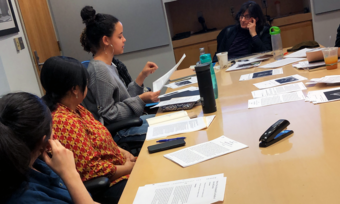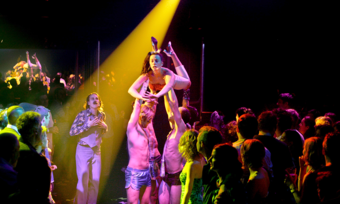Psychoanalysis and Breast Milk at the Boston Museum of Fine Arts
Onto Objects continued the new series of performance events at the Boston Museum of Fine Arts earlier this year. Curator Liz Munsell used this session to engage in diplomacy with the non-sentient residents of the museum, hosting Jeffrey Gibson and Patty Chang for performances with objects from the permanent collection. This was a clever move by Munsell: inviting artists to make acts of selection allowed them to participate in the curatorial process, a live human element that is at always at work in museums.
Stephanie Cardon, for Big, Red & Shiny, noticed how talkative Gibson and Chang were, against the taciturn school of performance favored in Boston, Massachusetts. Cardon's review uses the term "theatricality" and "theatrics" in the sense that art criticism favors: as a one-color quality, related to fake drama, directional lighting, and scripted dialogue. This is a commonplace term in the discourse of the art world—Cardon's use of it is appropriate to her context, and blameless—but the function of the term misses something about what theater actually is and does. If the practices of theater artists could be boiled down to the traditions of bad acting and proscenium staging, few would have the right to be interested in them.
Nevertheless, there is this bugbear of scripted dialogue. I have never been able to understand why scripted action—that is, deciding what you will do before doing it, as performance artists frequently do—escapes the sense of premeditation that clings to “theatrical” scripted speech. I suspect that speech is the same old trouble, and premeditation or “theatricality” the excuse for avoiding it. As Chang and Gibson demonstrated however, speech in performance draws on diverse traditions. Gibson, in a chaise lounge, gave the monologue of an analysand. Chang delivered a lecture, power-point slides and all. These traditions may be theatrical in the large sense that society is itself theatrical, but they are not based exclusively on red velvet institutions like the Comédie Française. To miss this blurs the color of the pieces; I approach them with the idea that articulating theatricalities might bring something to light.
Cardon objected to the staginess of a certain chapter in Jeffrey Gibson's performance, (titled simply Timeline 1.29.14). After beginning—in a top-floor, twentieth-century corner of the American wing—with a drumming ritual of great authority and power, it was certainly disconcerting to watch Gibson lie down on a sofa and answer touchy-feely, leading questions put to him by an art critic (Dennis Carr, Lynch Curator of Decorative Arts) cast as his analyst.
Gibson spoke at length about the objects he had chosen, with sketches of their personalities: a painting is angry, the ancient bowl is lonely, and so on. "These biographies felt predictable and rehearsed," Stephanie Cardon notes, "far less spontaneous than the music that had preceded them. And the illusion that the therapy session might have been candid once lost, all the questions the psychoanalyst put to Gibson began to sound leading and hollow."
But what does one expect? Psychoanalysis is an inherently private practice, meant to exorcise the primitive personal demons in a socially acceptable context—that is, with a professional and behind closed doors, where one's fakey acting is past criticism. For me, Gibson's use of this tradition, even his use of staginess, was quite canny. The autobiographial matter of his presentation turned on a criticism of artists like Jackson Pollock (mostly Pollock himself), who were agents of an elevated primitivism that depended upon the museum. Just so, hysterical women depended upon the offices of Dr. Freud. And likewise, the hysteria of the artist keeps the art critic in business.
Yet Cardon preferred the authenticity of the first section of Gibson's performance. So did I, if it comes to that: he circled the space and approached his selected objects with a drum; cone-shaped tin bells on his sport-coat sleeves beating in rhythm as he moved. There was a mystical element to this section of the piece, and Pollock's Troubled Queen and No.10 were remarkable, if not in themselves, when used as scores for action—embodied and reformed in Gibson's performance. Speaking to the paintings, "summoning their spirits" as he later described it, Gibson moved and made music for them—he made them and audible as if they were pieces of sheet music, accessed in semi-trance.
However, choosing a preference for this part of the performance ignores the political reality that is truly Gibson's subject. Drumming in costume with bells is surely authentic if not exactly spontaneous: it is part of an American Indian mystical tradition which, Gibson said, was purposefully stifled by American government organizations in the early twentieth century. There was certainly no place for such stuff in the museum. But there was a place for Pollock, a modern primitive who famously became the poster-child of American freedom in propaganda initiatives orchestrated by the CIA and its affiliate foundations during the Cold War. Pollock both required the luxury of the museum to exist, and thrived there. Native mysticism did not require a white room nor analysis by professional critics: it was not dependent upon their system, so could not be used as a hallmark of modernist experimentation as Pollock's primitivism could.
Timeline re-integrated native mystical practice with the Anglo-American modernist tradition. "To be civilized," Henry Miller observed, "is to have complicated needs": hence an artist is subjected to a kind of bris of the intellect by cultural gatekeepers, and must learn to depend upon critical analysis before becoming an acceptable member of an artistic class. Gibson presented his own version of this ritual, abandoning drum and chant for psychoanalysis, public expression for "private," historicized explanation of an obsessive tendency.
Patty Chang's Flash Burn in Uzbekistan made a perfect pair with Gibson's piece, for the issues she addressed lie along the same continuum. Where Gibson had been subjected to a feminizing tradition, psychoanalysis, Chang took on the masculine role of a semi-corporate power-point lecturer, seated at a desk, laptop glowing while she spoke. This is an irresponsible assertion about gender roles of course, but I urge the reader to consider the perspective in terms of dramatic shapes: a man lying on a chaise lounge, a woman (later, with a breast pump) operating a laptop behind a large desk. These mild choices speak in the theater of the mind. And in both cases, the chosen arrangement invoked a purposeful suppression of instinct—be it maternal or ancestral.
Chang performed in a replica of a Ming Dynasty room in the MFA, as she would for an informational lecture. Her subject, however, was obscure. Life, work, and history flowed through the presentation without any kind of boundary. There were careful citations in the spoken prose, but slides flashed according to mood or stream of consciousness, and strings of facts fell into and out of ecology, politics, personal life, and family history without ever reaching thesis or instruction. On the level of the sentence, the presentation seemed factual or instructive, a teaching tool. But taken together, it was a piece of stream-of-consciousness talk, laced with citations (mostly "according to Google") like cheeky jewelry. There was research behind the presentation, of a kind, yet it might have been an expressive monologue—with sense on the level of coalesced moods rather than statements—linking Chang's father's death with the destruction of the Chinese city named Shangri-La (after the fictional harmonious valley), the color of a particular kind of neon paper, and the gradual disappearance of the Aral sea. And of course it was made clear (though never in words) that Chang now has a child.
Gibson illustrated an abandonment of ancestral form for an externally imposed form, and so created a ritual that involved the abandonment of ritual. Chang's talk held another kind of two-poled tension: a drive like a storyteller's to communicate eternal realities of birth, life, death, and beauty in experience strained the conventions of public speech—and the success of expressing this kind of matter through impersonal conventions, and despite them. Her actions spoke to the same conflict.
Early in the lecture, Chang began cleaning herself like a cat, licking her hands and using her saliva to clean her face, her neck, her body. Later she produced a breast pump, unfastened her blouse, affixed the pump to herself, and let it work while she spoke of her visits to locations, her father's love of travel by car, and the details of his marriage and early life. Everywhere personal experience strained against the public form of her dry-voiced address, and her actions illustrated the strain of that compliance. These are the central metaphors of making art acceptable to the public, and useable by a large, impersonal world: to clean oneself up. To pull from oneself something that can nourish another.
These are the central metaphors of making art acceptable to the public, and useable by a large, impersonal world: to clean oneself up. To pull from oneself something that can nourish another.

Jizhou ware; stoneware, Museum of Fine Arts.
By the end of her presentation, Chang had two small bottles of milk. She poured the contents into a tea bowl dating from the Song Dynasty, of the twelfth or thirteenth century, with an impression of a leaf seared into the bottom by the laying on of an actual leaf before the glazing process. It was a proto-photographic impression: there in this ancient bowl was a leaf's color, its perfect shape—even the veins were visible. But of course, the bowl and not the leaf survives. Both Chang and Gibson's performances showed experience seared to ash by the regulations of institutions and that do not need the wild and unformed beauty of individual or ancestral experience. But what was left by the performance of this strain is a legible gesture, striking as the Song leaf. In both performances the drama of the artist was made visible and public, given form in struggle by theatrical traditions of the twentieth century: psychoanalysis and power-point. Through any tradition available, the artist wrings from personal experience a kind of offering to be left on the altar of the public good. There is no fitter place for this than the mausoleum of human drama that the museum always was, and always ought to be.
At last Chang rose from the replica tea house, leaving her power-point, the audience—and ancient bowl of milk on the table.









Comments
The article is just the start of the conversation—we want to know what you think about this subject, too! HowlRound is a space for knowledge-sharing, and we welcome spirited, thoughtful, and on-topic dialogue. Find our full comments policy here